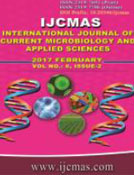


 National Academy of Agricultural Sciences (NAAS)
National Academy of Agricultural Sciences (NAAS)

|
PRINT ISSN : 2319-7692
Online ISSN : 2319-7706 Issues : 12 per year Publisher : Excellent Publishers Email : editorijcmas@gmail.com / submit@ijcmas.com Editor-in-chief: Dr.M.Prakash Index Copernicus ICV 2018: 95.39 NAAS RATING 2020: 5.38 |
A field experiment was conducted at the farm of Sorghum Research Unit Dr. P.D.K.V., Akola to study the effect of tillage and integrated nutrient management on sorghum productivity. The experiment was carried out during the kharif season of 2009 to 2011 in Split plot design in three replications. The treatments were as main plot -tillage practices(3) T1: Conventional tillage (1 summer ploughing before monsoon) + 2 harrowing + atrazine as pre-em + 1 hoeing + 1 hand weeding), T2: Reduced tillage (2 harrowing + atrazine as pre-em + 1 hand weeding) and T3: Minimum tillage (1 harrowing + atrazine as pre-em + 1 hand weeding) and each main plot sub divided into four Nutrient management practices-F1-100% RDF through inorganic, F 2-75% RDF through inorganic + 5t FYM/ha, F 3-50% RDF through inorganic + 5t FYM/ha + Azotobactor + PSB and F 4 -Control (Native fertility). From the three years data it is concluded that conventional tillage practice produced significantly highest plant height grain, fodder yield which was at par with reduced tillage practice. Application of 100% RDF through inorganic sources produced significantly highest grain, fodder yield which was at par with the application of 75% RDF through inorganic + 5 t FYM/ha.
 |
 |
 |
 |
 |